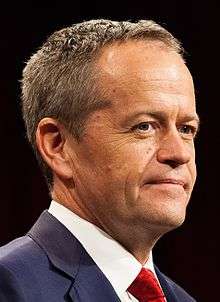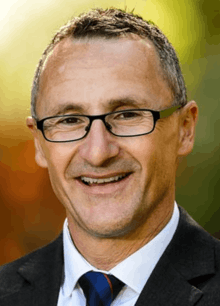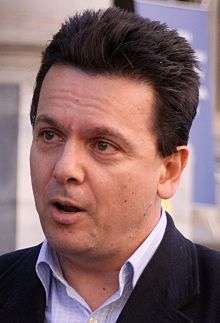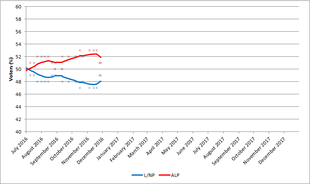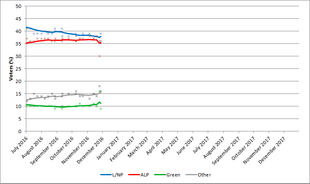Next Australian federal election
| | |||||||||||||||||||||||||||||||||||||||||||||||||||||||||||||||||||||||||||||||||||||||||||||||
| |||||||||||||||||||||||||||||||||||||||||||||||||||||||||||||||||||||||||||||||||||||||||||||||
| |||||||||||||||||||||||||||||||||||||||||||||||||||||||||||||||||||||||||||||||||||||||||||||||
| |||||||||||||||||||||||||||||||||||||||||||||||||||||||||||||||||||||||||||||||||||||||||||||||
The next Australian federal election will elect members of the 46th Parliament of Australia. The election will be called following the dissolution or expiry of the 45th Parliament as elected at the 2016 double dissolution federal election.
Except for another double dissolution, the next election must be held between August 2018 and May 2019 for half of the state senators and on or before 2 November 2019 for the House of Representatives and territory senators.
Australia has compulsory voting, uses full-preference instant-runoff voting in single member seats for the lower house, the 150-seat House of Representatives, and optional-preference single transferable voting in the proportionally represented upper house, the 76-seat Senate.
Previous election
Though federal election outcomes are traditionally called by political commentators on election night, even during the following day the outcome could not be predicted, with many close seats in doubt.[1][2][3][4][5] After a week of vote counting, still no party had won enough seats in the 150-seat House of Representatives to form a majority government.[6][7][8] Neither the incumbent Turnbull Government led by Prime Minister Malcolm Turnbull of the Liberal/National Coalition nor the Shorten Opposition led by Opposition Leader Bill Shorten of the Australian Labor Party were in a position to concede defeat or claim victory.[9][10] Many political commentators predicted a hung parliament such as occurred at the 2010 election.[8][11][12]
Turnbull repeatedly claimed prior to the election that a vote for a Labor, Green or Independent candidate was a vote for "the Labor/Green/Independent alliance",[13][14] and also refused to countenance a hung parliament.[15] However, during the uncertain week following the election, Turnbull negotiated with the crossbench and secured confidence and supply support from Bob Katter and from independents Andrew Wilkie and Cathy McGowan in the event of a hung parliament and resulting minority government.[16] During crossbench negotiations, Turnbull pledged additional staff and resources for crossbenchers, and stated "It is my commitment to work in every way possible to ensure that the crossbenchers have access to all of the information they need and all of the resources they need to be able to play the role they need in this parliament".[17] On 10 July, eight days after the election took place and following Turnbull's negotiations with the crossbench where he secured sufficient confidence and supply support, Shorten conceded defeat, acknowledging that the incumbent Coalition had enough seats to form either a minority or majority government. Turnbull claimed victory later that day.[18] In the closest federal majority result since the 1961 election, the ABC declared on 11 July that the incumbent Coalition would be able to form a one-seat majority government.[19] It was the first election result since federation where the opposition won more seats than the government in both of Australia's two most populous states, New South Wales and Victoria.[20]
Result
In the 150-seat House of Representatives, the one-term incumbent Liberal/National Coalition government was re-elected with a reduced 76 seats, a bare one-seat majority. Resulting from the national two-party swing against the government, the Labor opposition picked up a significant number of previously government-held seats − totaling 69 seats. On the crossbench the Greens, the Nick Xenophon Team, Katter's Australian Party, and independents Wilkie and McGowan won a seat each. On 19 July the Australian Electoral Commission (AEC) announced a re-count for the Coalition-held but provisionally Labor-won Division of Herbert. At the start of the Herbert re-count, Labor led by eight votes.[21][22] The AEC announced on 31 July that Labor had won Herbert by 37 votes.[23][24][25]
The final outcome in the 76-seat Australian Senate took over four weeks to complete despite significant voting changes. Earlier in 2016, legislation changed the Senate voting system from a full-preference single transferable vote with group voting tickets to an optional-preferential single transferable vote.[26] The final Senate result was announced on 4 August: Liberal/National Coalition 30 seats (−3), Labor 26 seats (+1), Greens 9 seats (−1), One Nation 4 seats (+4) and Nick Xenophon Team 3 seats (+2). Derryn Hinch won a seat, while Jacqui Lambie, Liberal Democrat David Leyonhjelm and Family First's Bob Day retained their seats. The number of crossbenchers increased by two to a record 20. The Liberal/National Coalition will require at least nine additional votes to reach a Senate majority, an increase of three.[27][28][29] As per convention, the government and opposition agreed to support a motion in the parliament that the first six senators elected in each state would serve a six-year term, while the last six elected would serve a three-year term.[30][31][32][33][34]
Marginal seat pendulum
Based on the 2016 post-election pendulum for the Australian federal election, this Mackerras pendulum has the Liberal/National Coalition government on 76 of 150 seats with the Labor opposition on 69 seats and a crossbench of five seats.
Assuming a theoretical uniform swing, for the Labor opposition to get to 76 seats and majority government would require Labor with 51.0% of the two-party vote from a 1.4-point two-party swing or greater, while for the incumbent Coalition to lose majority government would require the Coalition with 49.8% of the two-party vote from a 0.6-point two-party swing or greater.
The key marginal seats are as follows:
| Marginal Labor seats | |||
| Herbert (Qld) | Cathy O'Toole | ALP | 50.02 |
| Hindmarsh (SA) | Steve Georganas | ALP | 50.58 |
| Cowan (WA) | Anne Aly | ALP | 50.68 |
| Longman (Qld) | Susan Lamb | ALP | 50.79 |
| Batman (Vic) | David Feeney | ALP | 51.03 v GRN |
| Lindsay (NSW) | Emma Husar | ALP | 51.11 |
| Melbourne Ports (Vic) | Michael Danby | ALP | 51.38 |
| Griffith (Qld) | Terri Butler | ALP | 51.60 |
| Macquarie (NSW) | Susan Templeman | ALP | 52.19 |
| Braddon (Tas) | Justine Keay | ALP | 52.20 |
| Lyons (Tas) | Brian Mitchell | ALP | 52.31 |
| Eden-Monaro (NSW) | Mike Kelly | ALP | 52.93 |
| Perth (WA) | Tim Hammond | ALP | 53.33 |
| Bendigo (Vic) | Lisa Chesters | ALP | 53.74 |
| Richmond (NSW) | Justine Elliot | ALP | 53.96 |
| Moreton (Qld) | Graham Perrett | ALP | 54.02 |
| Bruce (Vic) | Julian Hill | ALP | 54.08 |
| Adelaide (SA) | Kate Ellis | ALP | 54.65 |
| Jagajaga (Vic) | Jenny Macklin | ALP | 54.67 |
| Dobell (NSW) | Emma McBride | ALP | 54.81 |
| Wills (Vic) | Peter Khalil | ALP | 54.88 v GRN |
| Lilley (Qld) | Wayne Swan | ALP | 55.32 |
| Isaacs (Vic) | Mark Dreyfus | ALP | 55.73 |

Government (76)
Coalition
Liberal (45)
LNP (21)
National (10)
Opposition (69)
Labor (69)
Crossbench (5)
Greens (1)
Katter (1)
Xenophon Team (1)
Independent (2)

Government (30)
Coalition
Liberal (21)
LNP (5)
National (3)
CLP (1)
Opposition (26)
Labor (26)
Crossbench (20)
Greens (9)
One Nation (4)
Xenophon Team (3)
Family First (1)
Liberal Democrat (1)
Lambie (1)
Hinch (1)
Opinion polls
Graphical summary
Voting intention
| Date | Firm | Primary vote | TPP vote | ||||
|---|---|---|---|---|---|---|---|
| L/NP | ALP | GRN | OTH | L/NP | ALP | ||
| 25-28 Nov 2016 | Essential[35] | 39% | 36% | 9% | 16% | 49% | 51% |
| 24–26 Nov 2016 | Ipsos[36] | 36% | 30% | 16% | 18% | 49% | 51% |
| 17–20 Nov 2016 | Newspoll[37] | 38% | 38% | 10% | 14% | 47% | 53% |
| 11–14 Nov 2016 | Essential[38] | 37% | 37% | 11% | 15% | 47% | 53% |
| 3–6 Nov 2016 | Newspoll[39] | 39% | 38% | 10% | 13% | 47% | 53% |
| 20–23 Oct 2016 | Newspoll[40] | 39% | 37% | 10% | 14% | 48% | 52% |
| 14-17 Oct 2016 | Essential[41] | 37% | 37% | 11% | 14% | 47% | 53% |
| 7-10 Oct 2016 | Essential[42] | 38% | 36% | 10% | 16% | 48% | 52% |
| 6–9 Oct 2016 | Newspoll[43] | 39% | 36% | 10% | 15% | 48% | 52% |
| 22–25 Sep 2016 | Newspoll[44] | 38% | 37% | 10% | 15% | 48% | 52% |
| 9–12 Sep 2016 | Essential[45] | 38% | 37% | 10% | 15% | 48% | 52% |
| 8–11 Sep 2016 | Newspoll[46] | 41% | 36% | 9% | 14% | 50% | 50% |
| 26–29 Aug 2016 | Essential[47] | 40% | 37% | 10% | 13% | 49% | 51% |
| 25–28 Aug 2016 | Newspoll[48] | 41% | 36% | 9% | 14% | 50% | 50% |
| 19–22 Aug 2016 | Essential[49] | 39% | 36% | 10% | 15% | 49% | 51% |
| 12–15 Aug 2016 | Essential[50] | 39% | 37% | 10% | 14% | 48% | 52% |
| 5–8 Aug 2016 | Essential[51] | 40% | 37% | 10% | 13% | 48% | 52% |
| 27 Jul – 1 Aug 2016 | Essential[52] | 39% | 37% | 10% | 14% | 48% | 52% |
| 20–24 Jul 2016 | Essential[53] | 39% | 37% | 10% | 14% | 48% | 52% |
| 13–17 Jul 2016 | Essential[54] | 39% | 36% | 10% | 15% | 49% | 51% |
| 6–10 Jul 2016 | Essential[55] | 41% | 36% | 10% | 13% | 49% | 51% |
| 30 Jun – 3 Jul 2016 | Essential[56] | 41% | 37% | 10% | 12% | 50% | 50% |
| 2 Jul 2016 election | 42.0% | 34.7% | 10.2% | 13.1% | 50.4% | 49.6% | |
| 28 Jun – 1 Jul 2016 | Newspoll[57] | 42% | 35% | 10% | 13% | 50.5% | 49.5% |
| 30 Jun 2016 | ReachTEL[58] | 42.8% | 34.6% | 10.7% | 12% | 51% | 49% |
| 27–30 Jun 2016 | Essential[59] | 42.5% | 34.5% | 11.5% | 12% | 50.5% | 49.5% |
| 28–29 Jun 2016 | Galaxy[60] | 43% | 36% | 10% | 11% | 51% | 49% |
| 26–29 Jun 2016 | Ipsos[61] | 40% | 33% | 13% | 14% | 50% | 50% |
Preferred prime minister and satisfaction
| Date | Firm | Preferred prime minister | Turnbull | Shorten | ||||
|---|---|---|---|---|---|---|---|---|
| Turnbull | Shorten | Satisfied | Dissatisfied | Satisfied | Dissatisfied | |||
| 24–26 Nov 2016 | Ipsos[36] | 51% | 30% | 45% | 45% | 37% | 53% | |
| 17–20 Nov 2016 | Newspoll[37] | 43% | 33% | 34% | 54% | 36% | 51% | |
| 3–6 Nov 2016 | Newspoll[39] | 42% | 32% | 30% | 58% | 36% | 51% | |
| 20–23 Oct 2016 | Newspoll[40] | 42% | 32% | 29% | 57% | 36% | 51% | |
| 6–9 Oct 2016 | Newspoll[43] | 45% | 30% | 31% | 56% | 35% | 51% | |
| 9–12 Sep 2016 | Essential[45] | 41% | 26% | 35% | 43% | 36% | 41% | |
| 8–11 Sep 2016 | Newspoll[46] | 43% | 31% | 34% | 53% | 35% | 52% | |
| 25–28 Aug 2016 | Newspoll[48] | 43% | 32% | 34% | 52% | 36% | 50% | |
| 5–8 Aug 2016 | Essential[51] | 40% | 30% | 38% | 43% | 37% | 41% | |
| 6–10 Jul 2016 | Essential[55] | 39% | 31% | 37% | 48% | 39% | 41% | |
| 2 Jul 2016 election | ||||||||
| 28 Jun – 1 Jul 2016 | Newspoll[57] | 48% | 31% | 40% | 47% | 36% | 51% | |
| 30 Jun 2016 | ReachTEL[58] | 52.9% | 47.1% | |||||
| 26–29 Jun 2016 | Ipsos[61] | 49% | 35% | 49% | 41% | 42% | 50% | |
| 23–26 Jun 2016 | Essential[62] | 40% | 29% | 40% | 40% | 37% | 39% | |
| ^ Remainder were "uncommitted" to either leader. | ||||||||
Timeline
- 30 August 2016 — First sitting of 45th Parliament
Election date
Section 13 of the Constitution of Australia requires that in half-Senate elections the election of State senators must take place within one year before the places become vacant. As the terms of half the senators end on 30 June 2019, the writs for a half-Senate election cannot be issued earlier than 1 July 2018, and the earliest possible date for a simultaneous House/half-Senate election is 4 August 2018.[63] There is no constitutional requirement for simultaneous elections for the Senate and the House of Representatives, and there are precedents for separate elections; however, governments and the electorate have long preferred that elections for the two Houses take place simultaneously. The latest that a half-senate election could be held must allow time for the votes to be counted and the writs to be returned before the new senators take up office on 1 July 2019. This took over a month in 2016, so practically the half-senate election needs to be held no later than 18 May 2019.
A House-only election can be called at any time during the parliamentary term. Whether held simultaneously with an election for the Senate or separately, an election for the House of Representatives must be held on or before 2 November 2019,[63] which is calculated under provisions of the Constitution and the Commonwealth Electoral Act 1918 (CEA). Section 28 of the Constitution provides that the term of a House of Representatives expires three years from the first sitting of the House, unless it is dissolved earlier. The last federal election was held on 2 July 2016. The 45th Parliament opened on 30 August 2016[64] and its term would expire on 29 August 2019.[65] Writs for election can be issued up to ten days after a dissolution or expiry of the House.[66] Up to 27 days can be allowed for nominations,[67] and the actual election can be set for a maximum of 31 days after close of nominations,[68] resulting in the latest election date for the House of Representatives of Saturday, 2 November 2019.
A double dissolution cannot take place within six months before the date of the expiry of the House of Representatives.[69] That means any double dissolution must be granted by 28 February 2019. Allowing for the same stages indicated above, the last possible date for a double dissolution election would be 4 May 2019.[63] This could only occur if a bill that had passed the House of Representatives was rejected by the Senate twice, at least three months apart.
Constitutional and legal provisions
The Constitutional and legal provisions which impact on the choice of election dates include:[70]
- Section 12 of the Constitution says: "The Governor of any State may cause writs to be issued for the election of Senators for that State"
- Section 13 of the Constitution provides that the election of Senators shall be held in the period of twelve months before the places become vacant.
- Section 28 of the Constitution says: "Every House of Representatives shall continue for three years from the first sitting of the House, and no longer, but may be sooner dissolved by the Governor-General."[71] Since the 45th Parliament of Australia opened on 30 August 2016, it will expire on 29 August 2019.
- Section 32 of the Constitution says: "The writs shall be issued within ten days from the expiry of a House of Representatives or from the proclamation of a dissolution thereof." Ten days after 29 August 2019 is 8 September 2019.
- Section 156 (1) of the CEA says: "The date fixed for the nomination of the candidates shall not be less than 10 days nor more than 27 days after the date of the writ".[67] Twenty-seven days after 8 September 2019 is 5 October 2019.
- Section 157 of the CEA says: "The date fixed for the polling shall not be less than 23 days nor more than 31 days after the date of nomination".[68] Thirty-one days after 5 October 2019 is 5 November 2019, a Tuesday.
- Section 158 of the CEA says: "The day fixed for the polling shall be a Saturday".[72] The Saturday before 5 November 2019 is 2 November 2019. This is therefore the latest possible date for the lower house election.
Redistributions
It is expected that a South Australian seat will be abolished due to national population shifts which have occurred since the state's last redistribution in 2011 − although South Australia's population is still increasing, faster increases in other states will probably see a reduction in South Australia's representation from 11 to 10 seats in the projected 149-seat House of Representatives. South Australia only relatively recently experienced this, twice, with the seats of Bonython and Hawker ending in 2004 and 1993 respectively. South Australia held a state-record 13 seats between the 1984 enlargement of parliament until 1993. For almost a century beforehand, only one other single-member seat was ever abolished in South Australia, Angas and Angas' earlier incarnation. South Australia is the least-populated state where the number of seats can change, as Tasmania and the territories are constitutionally guaranteed a consistent minimum number of seats regardless of population shifts and quotas.[73][74][75]
See also
- Australian federal election, 2016
- Members of the Australian House of Representatives, 2016–2019
- Members of the Australian Senate, 2016–2019
References
- ↑ "Insiders 90-minute post-election program". ABC TV. 3 July 2016.
- ↑ "Swing against Malcolm Turnbull's Coalition leaves election on a knife-edge". ABC News. Australia. 2 July 2016.
- ↑ "We don't have a winner, so what happens now?". ABC News. Australia. 3 July 2016.
- ↑ "What. Just. Happened?". ABC News. Australia. 3 July 2016.
- ↑ "How the night unfolded with no clear winner". The Guardian. Australia. 3 July 2016.
- ↑ "Election 2016: Ballot count could take a month to finalise, AEC says". ABC News. Australia. 4 July 2016. Retrieved 4 July 2016.
- ↑ Gough, Deborah (3 July 2016). "Australian federal election 2016: No results until at least ... Tuesday". Sydney Morning Herald. Retrieved 4 July 2016.
- 1 2 Jennifer Smith (3 July 2016). "'I can form a majority government': Malcolm Turnbull's confident he'll win the election and avoid a hung parliament as Bill Shorten praises Labor's 'magnificent campaign'... but there may not be a result until TUESDAY". Daily Mail Australia. Retrieved 4 July 2016.
- ↑ "Liberals 'cautiously optimistic' on majority". Sky News Australia. 4 July 2016. Retrieved 4 July 2016.
- ↑ Fergus Hunter (4 July 2016). "Australian federal election 2016: Bill Shorten says Malcolm Turnbull 'should quit'". Sydney Morning Herald. Retrieved 4 July 2016.
- ↑ Maher, Sid (4 July 2016). "Federal election 2016: here's the sequel, Hung Parliament II". The Australian. Retrieved 4 July 2016.
- ↑ Lenore Taylor (3 July 2016). "Turnbull and Shorten court independents with hung parliament in play". The Guardian. Australia. Retrieved 4 July 2016.
- ↑ "Malcolm Turnbull launches election campaign". The Australian. 26 June 2016.
- ↑ "Why Malcolm Turnbull Is So Scared Of People Voting Independents". Huffington Post. 27 June 2016.
- ↑ "Turnbull talks down protest vote". SBS News. 27 June 2016.
- ↑ "Bill Shorten predicts second poll as Cathy McGowan offers Coaltion support". The Sydney Morning Herald. 8 July 2016.
- ↑ "Malcolm Turnbull claims victory after Bill Shorten concedes defeat". ABC News. Australia. 10 July 2016.
- ↑ Ross, Monique (10 July 2016). "Election 2016: Malcolm Turnbull claims victory after Bill Shorten concedes defeat". ABC News. Australia. Retrieved 10 July 2016.
- ↑ "Election 2016: LNP retains Capricornia, gives Coalition 76-seat majority government". ABC News. Australia. 11 July 2016. Retrieved 11 July 2016.
- ↑ Australian Politics and Elections Database: University of Western Austrralia
- ↑ "Statement from the Australian Electoral Commission: Recount in the Division of Herbert" (Press release). Australian Electoral Commission. 19 July 2016. Retrieved 25 July 2016.
- ↑ "Federal Election 2016 Results". Australia Votes. Australian Broadcasting Corporation. 3 July 2016. Retrieved 3 July 2016.
- ↑ "Labor wins seat of Herbert after recount". Abc.net.au. 2016-07-31. Retrieved 2016-08-11.
- ↑ Federal Politics (2016-07-31). "Labor takes seat of Herbert, leaving Malcolm Turnbull with majority of just one seat". Smh.com.au. Retrieved 2016-08-11.
- ↑ Australian Electoral Commission. "Herbert - 2016 election". Vtr.aec.gov.au. Retrieved 2016-08-11.
- ↑ Nicole Hasham (3 July 2016). "Election 2016 results: Senate count throws up a wild mix as One Nation, Fred Nile, Liberal Democrats vie for seats". news.com.au. Retrieved 3 July 2016.
- ↑ "AEC". Twitter. Retrieved 2016-08-11.
- ↑ "Federal Election 2016: Senate Results". Australia Votes. Australian Broadcasting Corporation. 3 July 2016. Retrieved 4 July 2016.
- ↑ "Senate photo finishes". Blogs.crikey.com.au. 2016-07-12. Retrieved 2016-07-30.
- ↑ Senate terms: Derryn Hinch and Greens' Lee Rhiannon given three years - The Guardian 12 August 2016
- ↑ ALP-LNP deal to force senators back to poll in three years: The Australian 13 August 2016
- ↑ Coalition and Labor team up to clear out crossbench senators in 2019: SMH 12 August 2016
- ↑ Coalition flags first elected Senate plan: Sky News 12 August 2016
- ↑ Cormann raises 'first elected' plan to halve Senate terms for crossbenchers: The Australian 12 December 2016
- ↑ "The Essential Report" (PDF). Essential Vision. 29 November 2016. Retrieved 29 November 2016.
- 1 2 Mark Kenny (27 November 2016). "Crashing to zero: Malcolm Turnbull's support evaporates in Fairfax-Ipsos poll". The Age.
- 1 2 "Newspoll: Another Labor win as Turnbull loses his economic touch". The Australian. 21 November 2016. Retrieved 22 November 2016.
- ↑ "The Essential Report" (PDF). Essential Vision. 15 November 2016. Retrieved 21 November 2016.
- 1 2 "Newspoll: Labor vote highest since Turnbull became PM". The Australian. 8 November 2016. Retrieved 8 November 2016.
- 1 2 "Turnbull hits lowest rating as Labor maintains lead, says Newspoll". The Australian. 24 October 2016. Retrieved 25 October 2016.
- ↑ "The Essential Report" (PDF). Essential Vision. 18 October 2016. Retrieved 18 October 2016.
- ↑ "The Essential Report" (PDF). Essential Vision. 11 October 2016. Retrieved 11 October 2016.
- 1 2 "Newspoll: Labor still leading, 100 days since election". The Australian. 9 October 2016. Retrieved 10 October 2016.
- ↑ "Newspoll: biggest lead for Labor in Malcolm Turnbull era". The Australian. 27 September 2016. Retrieved 26 September 2016.
- 1 2 "The Essential Report 13 September 2016" (PDF). Essential Vision. Essential Research. Retrieved 14 September 2016.
- 1 2 "Newspoll: Turnbull trails Shorten with Coalition and ALP in tie". The Australian. 12 September 2016. Retrieved 2016-09-13.
- ↑ "The Essential Report" (PDF). 30 August 2016. Retrieved 2016-08-31.
- 1 2 "Newspoll: Malcolm Turnbull in plunge to new low". The Australian. 30 August 2016. Retrieved 2016-08-30.
- ↑ "The Essential Report" (PDF). 23 August 2016. Retrieved 2016-08-31.
- ↑ "The Essential Report" (PDF). 16 August 2016. Retrieved 2016-08-18.
- 1 2 "The Essential Report" (PDF). 9 August 2016. Retrieved 2016-08-11.
- ↑ "Essential: 2 August 2016" (PDF). 2 August 2016. Retrieved 2016-08-11.
- ↑ "The Essential Report" (PDF). Retrieved 2016-08-11.
- ↑ "The Essential Report" (PDF). Retrieved 2016-08-11.
- 1 2 "The Essential Report" (PDF). Retrieved 2016-08-11.
- ↑ "The Essential Report" (PDF). Retrieved 2016-08-11.
- 1 2 "Turnbull clings to narrow lead". The Australian. 2 July 2016. Retrieved 2016-08-11.
- 1 2 "1 July 2016 ReachTEL". Reachtel.com.au. 1 July 2016. Retrieved 2016-08-11.
- ↑ "The Essential Report" (PDF). 1 July 2016. Retrieved 2016-08-11.
- ↑ "Fairfax-Ipsos: 50-50; Galaxy: 51-49 to Coalition – The Poll Bludger". 30 June 2016. Retrieved 2016-06-30.
- 1 2 "Fairfax-Ipsos poll: Dead heat on election eve as final poll points to cliffhanger". theage.com.au. 30 June 2016. Retrieved 2016-06-30.
- ↑ "Essential: 28 June 2016" (PDF). 28 June 2016. Retrieved 2016-08-11.
- 1 2 3 Green, Antony (12 November 2013). "Timetable for the Next Federal Election". abc.net.au. Retrieved 12 August 2016.
- ↑ "2016 Parliamentary sittings". Parliament of Australia. Retrieved 12 August 2016.
- ↑ See Anthony Green's Election Blog
- ↑ Section 32 of the Constitution
- 1 2 Commonwealth Electoral Act, s. 156
- 1 2 Commonwealth Electoral Act, s. 157
- ↑ Section 57 of the Constitution
- ↑ Rob Lundie, Australian elections timetable, Parliament of Australia
- ↑ Commonwealth Of Australia Constitution Act – Section 28
- ↑ Commonwealth Electoral Act, s. 158
- ↑ Electoral redistributions during the 45th Parliament: APH Statistics and Mapping 25 August 2016
- ↑ South Australia to potentially lose federal seat under future redistribution: ABC 25 August 2016
- ↑ South Australia set to be reduced to 10 federal electorates: The Advertiser 25 August 2016

